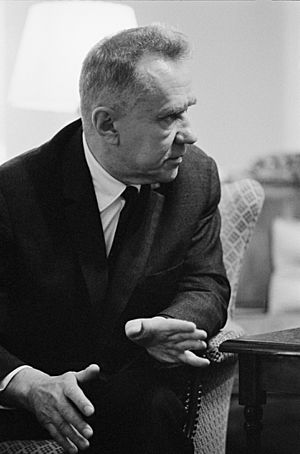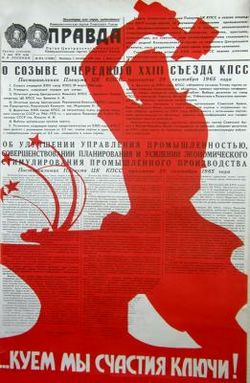Alexei Kosygin facts for kids
Quick facts for kids
Alexei Kosygin
Алексе́й Косы́гин |
|||||||||||||||||||||||||||||||||||||||
|---|---|---|---|---|---|---|---|---|---|---|---|---|---|---|---|---|---|---|---|---|---|---|---|---|---|---|---|---|---|---|---|---|---|---|---|---|---|---|---|

Kosygin in 1966
|
|||||||||||||||||||||||||||||||||||||||
| 8th Premier of the Soviet Union | |||||||||||||||||||||||||||||||||||||||
| In office 15 October 1964 – 23 October 1980 |
|||||||||||||||||||||||||||||||||||||||
| President | Anastas Mikoyan Nikolai Podgorny Leonid Brezhnev |
||||||||||||||||||||||||||||||||||||||
| Deputy | |||||||||||||||||||||||||||||||||||||||
| Leader | Leonid Brezhnev | ||||||||||||||||||||||||||||||||||||||
| Preceded by | Nikita Khrushchev | ||||||||||||||||||||||||||||||||||||||
| Succeeded by | Nikolai Tikhonov | ||||||||||||||||||||||||||||||||||||||
| First Deputy Premier of the Soviet Union | |||||||||||||||||||||||||||||||||||||||
| In office 4 May 1960 – 15 October 1964 |
|||||||||||||||||||||||||||||||||||||||
| Premier | Nikita Khrushchev | ||||||||||||||||||||||||||||||||||||||
| Preceded by | Frol Kozlov | ||||||||||||||||||||||||||||||||||||||
| Succeeded by | Dmitriy Ustinov | ||||||||||||||||||||||||||||||||||||||
|
|||||||||||||||||||||||||||||||||||||||
| Personal details | |||||||||||||||||||||||||||||||||||||||
| Born | 21 February [O.S. 8 February] 1904 Saint Petersburg, Russian Empire |
||||||||||||||||||||||||||||||||||||||
| Died | 18 December 1980 (aged 76) Moscow, Russian SFSR, Soviet Union |
||||||||||||||||||||||||||||||||||||||
| Resting place | Kremlin Wall Necropolis, Moscow | ||||||||||||||||||||||||||||||||||||||
| Citizenship | Soviet | ||||||||||||||||||||||||||||||||||||||
| Nationality | Russian | ||||||||||||||||||||||||||||||||||||||
| Political party | Communist Party of the Soviet Union (1927–1980) | ||||||||||||||||||||||||||||||||||||||
| Spouse | Klavdia Andreyevna (died 1967) | ||||||||||||||||||||||||||||||||||||||
| Residence | House on the Embankment | ||||||||||||||||||||||||||||||||||||||
| Profession | Teacher, civil servant | ||||||||||||||||||||||||||||||||||||||
| Awards | |||||||||||||||||||||||||||||||||||||||
| Military service | |||||||||||||||||||||||||||||||||||||||
| Allegiance | Russian SFSR | ||||||||||||||||||||||||||||||||||||||
| Branch/service | Red Army | ||||||||||||||||||||||||||||||||||||||
| Years of service | 1919–1921 | ||||||||||||||||||||||||||||||||||||||
| Rank | Conscript | ||||||||||||||||||||||||||||||||||||||
| Commands | Red Army | ||||||||||||||||||||||||||||||||||||||
| Battles/wars | Russian Civil War | ||||||||||||||||||||||||||||||||||||||
Alexei Nikolayevich Kosygin (Russian: Алексе́й Никола́евич Косы́гин; 21 February 1904 – 18 December 1980) was an important Soviet leader during the Cold War. He served as the Premier of the Soviet Union from 1964 to 1980. He was one of the most powerful Soviet politicians in the mid-1960s, working alongside Leonid Brezhnev.
Kosygin was born in Saint Petersburg in 1904 to a working-class family. He joined the army during the Russian Civil War. After the war, he worked as a manager in factories in Siberia. He returned to Leningrad (now Saint Petersburg) in the 1930s and quickly moved up in the Soviet government. During World War II, he helped move Soviet factories away from areas the German army was invading.
After the war, Kosygin continued to rise in power. He became the chairman of the State Planning Committee in 1959. When Nikita Khrushchev was removed from power in 1964, Kosygin became Premier. He shared power with Brezhnev, who became the First Secretary, and Nikolai Podgorny, who was the head of state. This group was known as a "troika," meaning three leaders.
At first, Kosygin was the most influential leader in this group. He managed the Soviet economy and played a big role in foreign policy. He led talks with the United States about arms control. However, after events like the Prague Spring in 1968, Brezhnev became more powerful. Kosygin stayed in his role until he had to retire in October 1980 due to poor health. He passed away two months later.
Contents
Early Life and Career (1904–1964)
Alexei Kosygin was born in Saint Petersburg into a working-class family. His parents were Nikolai Ilyich and Matrona Alexandrovna. He was baptized a month after his birth. Sadly, his mother died when he was very young, and his father raised him.
He and his father supported the Russian Revolution. At 14, Alexei joined a labor army on the side of the Bolsheviks during the Russian Civil War (1917–1922). After leaving the Red Army in 1921, Kosygin went to a technical school. He then worked in consumer co-operatives in Novosibirsk, Siberia. He stayed there for six years.
Rising in Government Before the War
Kosygin joined the Communist Party of the Soviet Union in 1927. In 1930, he returned to Leningrad to study at the Leningrad Textile Institute, graduating in 1935. After his studies, he worked as a foreman and then a manager in a textile factory. He quickly moved up in his career during a time of big changes in the Soviet Union.
In 1937, he became the director of the October Textile Factory. By 1938, he was in charge of industry and transport for the Leningrad communist party. Later that year, he became the 'mayor' of Leningrad City. In 1939, he was made the People's Commissar for Textile and Industry. He also earned a seat on the Central Committee. In 1940, Kosygin became a Deputy Chairman of the Council of People's Commissars.
During World War II
The State Defence Committee gave Kosygin important tasks during World War II, also known as the Great Patriotic War.
As a deputy chairman, he was in charge of moving factories out of areas that the Axis powers were about to take over. Under his leadership, 1523 factories, along with many raw materials and equipment, were moved eastward. Kosygin also helped keep the railroads running smoothly.
During the Siege of Leningrad, he went to his hometown. He managed the building of an ice road and a pipeline across Lake Ladoga. This allowed about half a million people to be evacuated from the city. It also supplied fuel to factories and power plants.
In 1943, Alexei Kosygin became the Chairman of the government of the Russian SFSR. In 1944, he was appointed to lead the Currency Board of the Soviet Union.
After the War
Kosygin became a candidate member of the Politburo in 1946. During the Soviet famine of 1946–47, he led efforts to deliver food to the areas suffering the most. In February 1948, he became the USSR Minister for Finance. On 4 September 1948, he became a full member of the Politburo. This made him one of the top officials in the USSR.
His excellent management skills caught the attention of Joseph Stalin. Stalin shared important information with Kosygin. He even sent Kosygin to check on the homes of other top officials.
A Difficult Time
Kosygin's supporter, Andrei Zhdanov, died suddenly in August 1948. After this, Zhdanov's rivals, Lavrenty Beria and Georgy Malenkov, convinced Stalin to remove Zhdanov's allies. Kosygin was one of these allies. Many others were arrested and even executed in what was called the Leningrad affair. Kosygin was moved to a less important job as USSR Minister for Light Industry. He kept his Politburo membership until 1952, but his power was greatly reduced.
During this time, Kosygin and his son-in-law, Mikhail Gvishiani, were very worried. They even searched their homes for listening devices. Kosygin never left home without telling his wife what to do if he didn't return. After two years of fear, they realized Stalin would not harm them.
The Khrushchev Years
In September 1953, six months after Stalin's death, Kosygin was appointed USSR Minister for Industrial Goods. In December, he was again made a Deputy Chairman of the Council of Ministers. He lost that position in 1956 but was appointed Deputy Chairman of the State Economic Commission.
When Nikita Khrushchev was in a power struggle in 1957, Kosygin supported him. Kosygin believed that if Khrushchev's opponents had won, there would have been more violence. However, some observers noted that Kosygin didn't owe much to Khrushchev and was not eager to praise him.
Despite this, Kosygin's career steadily recovered. In June 1957, he was again appointed a Deputy Chairman of the Council of Ministers. He also became a candidate member of the Presidium Central Committee (the new name for the Politburo). In March 1959, he became Chairman of Gosplan, the state planning committee. On 4 May 1960, he was promoted to First Deputy Chairman of the Council of Ministers and a full member of the Presidium.
As First Deputy Premier, Kosygin traveled abroad for trade missions. He visited countries like North Korea, India, Argentina, and Italy. After the Cuban Missile Crisis, Kosygin became the Soviet spokesperson for better relations with the United States. From 1960 to 1962, Kosygin was one of the "big four" leaders. However, in November 1962, after Khrushchev criticized his economic plans, Kosygin was removed from the inner leadership group.
Premiership
Sharing Power with Brezhnev
When Khrushchev was removed from power in October 1964, Kosygin became Premier. He was part of a collective leadership with Leonid Brezhnev (who became general secretary) and Nikolai Podgorny (who became head of state). This new leadership was more traditional than Khrushchev's.
Kosygin, Podgorny, and Andrei Kirilenko were the most open to reforms. Brezhnev and Arvīds Pelše were more moderate. Mikhail Suslov led the party's traditional wing.
Soon after, Brezhnev began to criticize Kosygin. Newspapers like Pravda said the Council of Ministers, led by Kosygin, was planning the economy poorly. They used strong words against Kosygin, similar to those used against Khrushchev.
Brezhnev criticized Kosygin's focus on making more consumer goods. He said it was too much like Western policies. At the 23rd Party Congress, Brezhnev's supporters increased spending on defense and agriculture, weakening Kosygin's position. Kosygin and Podgorny often disagreed, which made it hard for them to work together against Brezhnev.
By 1970, there was growing unhappiness within the Soviet leadership. Many doubted the country's policies. Issues included the handling of the Prague Spring (which Kosygin initially opposed), problems in agriculture, the Sino–Soviet border conflict (he wanted peace), the Vietnam War, and arms talks with the US.
By March 1971, it was clear that Brezhnev was the main leader. Kosygin became the spokesperson for the new five-year plan. Podgorny's position also grew stronger within the leadership.
Foreign Relations
Early in his time as Premier, Kosygin wanted to be the one to represent the Soviet Union abroad. He believed this role belonged to the head of government, like in other countries. For a short time, this happened, leading Henry Kissinger to think Kosygin was the main Soviet leader. However, after Brezhnev became more powerful, Kosygin was rarely seen outside the Soviet bloc. This was also because Foreign Minister Andrei Gromyko didn't like Kosygin getting involved in foreign affairs.
The Six-Day War in the Middle East led to more cooperation between the Soviet Union and the United States. To improve relations, the US invited Kosygin to a meeting with President Lyndon B. Johnson. This meeting was called the Glassboro Summit Conference. They didn't agree on limiting missile systems, but the meeting was friendly. This was called the "Spirit of Glassboro." Relations improved further when the 1970 Moscow Treaty was signed with West Germany.
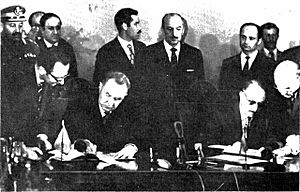
Kosygin became good friends with Finland's President Urho Kekkonen. This helped the USSR trade with Finland and keep it out of Cold War conflicts.
In 1972, Kosygin signed a Treaty of Friendship and Cooperation with Iraq. This built on strong Soviet ties with the Iraqi government.
Kosygin supported János Kádár's economic reforms in Hungary. He protected Hungary from interference by other Soviet leaders. The new Polish leader, Edward Gierek, tried to improve Poland's economy by borrowing money from Western countries. The Soviet leaders approved these economic experiments. They wanted to reduce their large financial support to Eastern Bloc countries. During discussions about a possible Soviet invasion of Czechoslovakia, Kosygin warned about the consequences, remembering the Hungarian Revolution of 1956.
Kosygin helped mediate between India and Pakistan in 1966. He got both nations to sign the Tashkent Declaration. He also became the main spokesperson for arms control. Many of his colleagues felt he did his work "stoically" but lacked "enthusiasm" for international politics.
The Sino-Soviet split (a disagreement between the Soviet Union and China) upset Kosygin greatly. He visited Beijing in 1969 to try and ease tensions. He believed that since both were communist, they should be able to agree. However, his view changed later. He reportedly saw China as a "military dictatorship" wanting to control Asia.
During a visit from Afghan leaders, Kosygin criticized them for their harsh actions. He promised more economic and military help. But he rejected any idea of Soviet military involvement in Afghanistan. He believed it would harm the USSR's relations with Western countries. However, without Kosygin present, the Politburo later decided to intervene.
Economic Policy
Five-Year Plans
The Eighth Five-Year Plan (1966–1970) was a very successful time for the Soviet economy. It was especially good for making consumer goods. This period became known as the "golden era." The 23rd Party Congress and the Ninth Five-Year Plan (1971–1975) were delayed by Brezhnev due to power struggles. At the 23rd Party Congress, Kosygin promised that the Ninth Five-Year Plan would increase food, clothing, and household appliances by up to 50 percent. He said the plan would greatly improve the Soviet standard of living.
The Tenth Five-Year Plan (1976–1981) was called the "plan of quality" by Kosygin. Brezhnev did not agree with Kosygin's idea to make more consumer goods. As a result, consumer goods made up only 26 percent of industrial production. Kosygin was reportedly very angry about this decision. He said increased defense spending would "completely ruin" the Soviet Union. This plan was less ambitious than earlier ones.
The "Kosygin" Reform
Like Khrushchev, Kosygin tried to improve the command economy while keeping it socialist. In 1965, Kosygin started an economic reform known as the "Kosygin reform." He wanted to make Soviet industry more efficient. He suggested using some market ideas, like allowing factories to make a profit. He also tried to increase production and give more incentives to managers and workers. This would free managers from strict centralized government control. Khrushchev had liked the idea in 1964 and started some early steps. Brezhnev allowed the reform to continue because the Soviet economy was growing slowly.
The reform was inspired by the economist Evsei Liberman. Kosygin believed that the Soviet government could manage the economy well. However, his changes to Liberman's ideas, especially about decentralization, caused the reform to fail, according to critics.
Kosygin thought that giving more power to local areas, having semi-public companies, and using cooperatives were key to catching up with Western economies. His reform aimed to slowly change from a "state-controlled economy" to one where "the state only guides businesses." The reform was put in place but had problems early on.
Results of the Reform
Salaries for Soviet citizens increased greatly, almost 2.5 times during the plan. Real wages in 1980 were 232.7 rubles, compared to 166.3 rubles before the reform. The period from 1965 to 1981 showed strong growth because of the Kosygin reform. The average yearly growth in retail sales was 11.2 billion rubles. This was much higher than before the reform. People bought more goods and everyday items. The use of home appliances increased a lot. For example, refrigerator sales went from 109,000 in 1964 to 440,000 units by 1973. Car production also increased and continued to grow until the late 1980s. The Soviet leaders tried to offer more attractive goods to consumers.
The removal of Khrushchev in 1964 ended his "housing revolution." Housing construction dropped between 1960 and 1964. After this, it increased sharply between 1965 and 1966. Then it grew steadily. While the housing shortage was never fully solved, the reform helped to reverse the negative trend and restart growth in housing construction.
End of the Reform
Growing opposition to the reform, its initial poor results, and Kosygin's reform ideas led to public disapproval. Kosygin lost many of his special benefits. However, Brezhnev could never remove him from his position as Chairman of the Council of Ministers, even though Kosygin's power was weaker. After his reform failed, Kosygin spent his time trying to improve economic management by changing targets. He started programs to improve food supplies and increase production. There is no clear proof that the reform caused the high growth in the late 1960s. Also, there is no proof that its cancellation caused the economy to slow down in the 1970s.
Later Reforms in 1973 and 1979
Kosygin started another economic reform in 1973. He wanted to reduce the power of the central Ministries and give more power to regional and local authorities. This reform did not achieve Kosygin's goals and was later canceled. However, it did create "associations," which were organizations representing different businesses.
The last major reform before the perestroika era was started by Kosygin's fifth government in 1979. It was called "Improving planning and reinforcing the effects of the economic mechanism on raising the effectiveness in production and improving the quality of work." This 1979 reform aimed to increase the central government's involvement in the economy. It did this by giving more duties and responsibilities to the ministries. Because Kosygin resigned in 1980 and Nikolai Tikhonov (his successor) was more traditional, very little of this reform was actually put into practice.
Later Life and Retirement
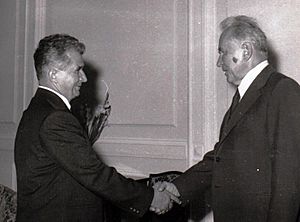
By the early to mid-1970s, Brezhnev had become strong enough to be the effective leader. According to historian Ilya Zemtsov, Kosygin "began to lose power" after the 24th Party Congress in 1971. This was when the phrase "the Politburo led by Brezhnev" became common. Brezhnev also worked to strengthen the Party's control over the government, further weakening Kosygin. Historian Robert Wesson noted that Kosygin's economic report in 1976 showed the end of the power struggle between them. To make things worse for Kosygin, Brezhnev published his memoirs, claiming he, not Kosygin, made all major economic decisions. Brezhnev also stopped any future talks about economic reform.
Brezhnev strengthened his own power by giving more authority to Podgorny as Chairman of the Presidium of the Supreme Soviet (head of state). The 1977 Soviet Constitution gave the head of state some executive powers, making the Council of Ministers (led by Kosygin) answerable to the Presidium. When Brezhnev replaced Podgorny as head of state in 1977, Kosygin's daily role in government was greatly reduced. Rumors spread that Kosygin would retire due to poor health.
Kosygin's influence in the Politburo weakened throughout the 1970s. He was often in the hospital. His First Deputy Chairman, Kiril Mazurov, often had to act in his place. Kosygin had his first heart attack in 1976. After this, he seemed to lose his energy and desire to work. He tried to resign twice between 1976 and 1980, but his resignations were not accepted. During Kosygin's sick leave, Brezhnev appointed Nikolai Tikhonov as First Deputy Chairman. Tikhonov was traditional, like Brezhnev, and he further reduced Kosygin's role. At a meeting in June 1980, Tikhonov, not Kosygin, presented the Soviet economic development plan. Kosygin's powers as Premier became so small that he had to discuss all decisions with Brezhnev.
Death
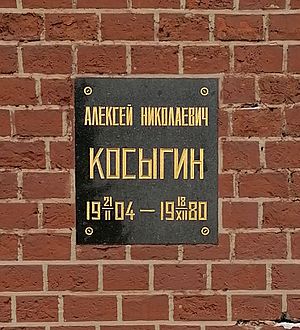
Kosygin was hospitalized in October 1980. While there, he wrote a short letter of resignation. The next day, he lost all government protection, communication, and luxury items he had earned. Kosygin died on 18 December 1980 in Moscow. None of his Politburo colleagues, former assistants, or security guards visited him. Near the end of his life, Kosygin worried that the Eleventh Five-Year Plan (1981–1985) would completely fail. He felt the current leadership was unwilling to reform the struggling Soviet economy. His funeral was delayed for three days because he died on the eve of Brezhnev's birthday and the day of Stalin's. Brezhnev praised Kosygin as someone who "worked selflessly for the good of the Soviet state." A state funeral was held, and Kosygin was honored by his peers. Brezhnev, Yuri Andropov, and Tikhonov placed an urn with his ashes at the Kremlin Wall Necropolis.
Personality
Compared to other Soviet officials, Kosygin was seen as practical and quite independent. An anonymous high-ranking official described Kosygin as "a lonely and somewhat tragic figure." He understood the problems of the Soviet Union but preferred to be careful. A former co-worker said, "He always had an opinion of his own, and defended it. He was very alert and performed brilliantly during negotiations."
Canadian Prime Minister Pierre Trudeau said Kosygin was like "Khrushchev without the rough edges." He called him a "fatherly man" who was a bit like Mikhail Gorbachev. Trudeau noted that Kosygin was willing to discuss issues as long as the Soviet position was not directly attacked. Former United States Secretary of State Henry Kissinger said that Kosygin was extremely dedicated to his work. Western diplomats saw Kosygin as a practical person with a "cold outside" who was traditional but not too strict. Andrei Sakharov, a Soviet dissident, believed Kosygin was "the most intelligent and toughest man in the Politburo." Singapore Prime Minister Lee Kuan Yew remembered Kosygin as "very quiet-spoken, but very determined, with a mind of great ability." David Rockefeller admitted that Kosygin was a talented manager who did amazing things in running the complex Soviet economy.
Legacy
Historical Views
Kosygin proved to be a very skilled administrator. The Soviet standard of living improved a lot because of his moderate reform policies. Kosygin's 1965 reform, like Nikita Khrushchev's "thaw," encouraged more reform in the Soviet Union. While Leonid Brezhnev wanted to keep the planned economy centralized, Kosygin tried to improve the struggling economic system by giving more control to local areas. After Brezhnev's death in 1982, the reform movement split. Some followed Yuri Andropov's path of strict control, while others followed Gorbachev's path of opening up public life.
Ilya Zemtsov, author of Chernenko: The Last Bolshevik, describes Kosygin as "determined and intelligent, an outstanding administrator." He says Kosygin stood out from other Soviet leaders because of his "extraordinary capacity for work." Historians Moshe Lewin and Gregory Elliott call him a "phenomenal administrator." David Law says his strength was "his exceptional capability as an administrator." Law also believes Kosygin was a "competent politician." Historians Evan Mawdsley and Stephen White claim that Brezhnev could not remove Kosygin because he was Brezhnev's last "capable administrator." In their book, The Unknown Stalin, Roy Medvedev and Zhores Medvedev called Kosygin an "outstanding organizer." Historian Archie Brown believes the 1965 Soviet economic reform was too "modest." He also thinks Kosygin was "too much a product of the Soviet ministerial system" to be a radical economic reformer. However, Brown does believe Kosygin was "an able administrator." Gvishiani, a Russian historian, concluded that "Kosygin survived both Stalin and Khrushchev, but did not manage to survive Brezhnev."
The Soviet people liked Kosygin, and he is still seen as an important figure in Russian and Soviet history today. Because of Kosygin's popularity, Brezhnev became "strongly jealous" of him, according to Nikolai Egorychev. Mikhail Smirtyukov, a former official, remembered that Kosygin refused to go drinking with Brezhnev, which annoyed Brezhnev greatly. Nikolai Ryzhkov, the last Chairman of the Council of Ministers, spoke in 1987 about the "sad experiences of the 1965 reform." He claimed that everything got worse after the reform was canceled.
Honours
During his life, Kosygin received seven Orders and two Awards from the Soviet state. He was given two Hero of Socialist Labour (USSR) awards. One was on his 60th birthday in 1964 by the Presidium of the Supreme Soviet. On this occasion, he also received an Order of Lenin and a Hammer and Sickle Gold Medal. On 20 February 1974, for his 70th birthday, he received another Order of Lenin and his second Hammer and Sickle Gold Medal. In total, Kosygin was awarded six Orders of Lenin, one Order of the October Revolution, and one Order of the Red Banner of Labour. During a visit to Peru in the 1970s with Leonid Brezhnev and Andrei Gromyko, all three received the Grand Cross of the Order of the Sun from President Francisco Morales Bermúdez. The Moscow State Textile University was named in his honor in 1981. In 1982, a statue of Kosygin was placed in Leningrad (now Saint Petersburg). In 2006, the Russian Government named a street after him.
Foreign Honours
- Bangladesh Liberation War Honour (Bangladesh Muktijuddho Sanmanona)
See also
 In Spanish: Alekséi Kosyguin para niños
In Spanish: Alekséi Kosyguin para niños


